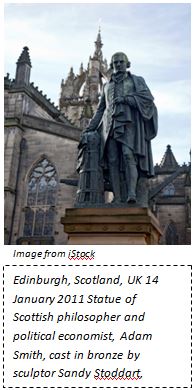Smith, Adam
View FREE Lessons!
Who was Adam Smith?
Adam Smith was a Scottish economist, philosopher, and author who wrote
An Inquiry into the Nature and Causes of the Wealth of Nations (commonly known as
The Wealth of Nations) in 1776 and claimed that individuals and businesses acting independently also act in society’s best interest.
Detailed Explanation:

Many view Adam Smith as the father of economics. His views in 1776 continue to influence economic theory and economic policy today. Born in Scotland in 1723, Adam Smith lived during the period following the Treaty of Union between Scotland and England which opened trade between these countries. He also lived during the early stages of the Industrial Revolution, when many items went from being handcrafted to machine-made. He was admitted to the University of Glasgow at 14! Later he wrote two influential books,
The Theory of Moral Standards in 1759, and
An Inquiry Into the Nature and Causes of the Wealth of Nations, more commonly called
The Wealth of Nations, in 1776. His objective was to explain why some countries were wealthier than others, but he explained so much more. His conclusion that minimal government intervention results in a nation's greater prosperity became the foundation for
laissez-faire (leave alone) policy.
Mercantilism was the predominant economic system during Adam Smith’s life. Monarchs managed their economies. Wealth was measured in gold and silver, so economic and political policies centered on amassing gold and silver. This was a period of great exploration and plundering of regions in the quest for precious metals and trading partners. Colonization was common as a source of trade and raw materials to be used in production. Mercantilists believed exports amassed wealth because the produced goods were sold for gold and silver.
However, locally sold items did little to grow wealth because no additional gold or silver was imported when local citizenry bought items. Adam Smith wrote that stockpiling gold and silver does not produce wealth by itself. It is the worker who toils and builds goods and services that creates wealth. Furthermore, Adam Smith believed individuals acting in their own interest make the best decisions for society as a whole. He wrote, “It is not from the benevolence of the butcher the brewer or the baker that we expect our dinner, but from their regard for their own interest.” The butcher, brewer, and baker provide our dinner to earn a profit, not because they like us. They are interested in producing efficiently because doing so minimizes their costs. Adam Smith referred to the market force that drives consumers and producers to act as an "invisible hand". He stated that personal self-interest and market prices act as an invisible hand driving the economy in a direction that promotes the most efficient use of a society’s resources, thereby benefiting the society. The economic forces behind the invisible hand are consumer and producer behaviors as exhibited by the law of demand and the law of supply. There is no coercion. Consumers and producers act in their own self-interest.
Adam Smith also recognized the benefits from specialization and division of labor. He used the pin-maker to illustrate. One man may be able to produce twenty pins in a day. Production is broken into approximately eighteen tasks. Smith refers to a factory he visited where ten men produced 48,000 pins in a day. Clearly, ten men could produce pins more efficiently than one by dividing up the labor. Adam Smith saw how this same idea was applicable to countries. Countries should specialize in producing where they have an advantage and trade for the other goods and services they need.
Follow the link to read The
Wealth of Nations.
Dig Deeper With These Free Lessons:
Economic Systems
Supply and Demand – Producers and Consumers Reach Agreement
Fundamental Economic Assumptions
Comparative Advantage and Specialization